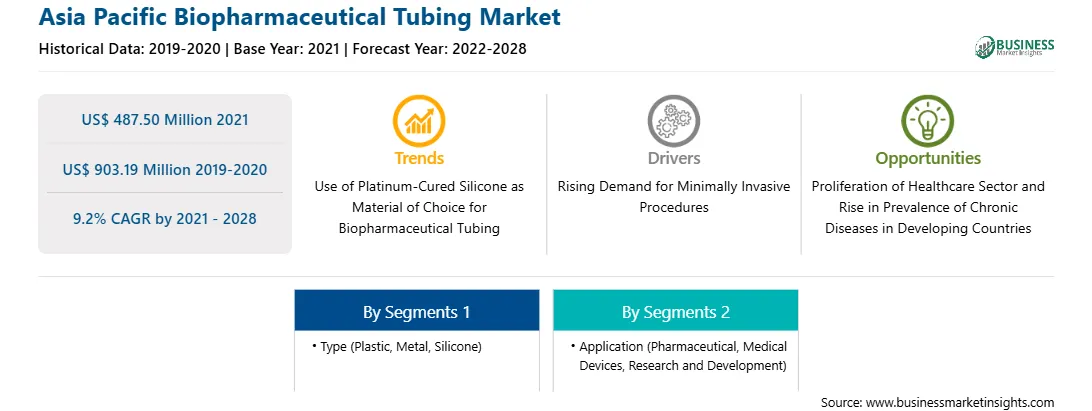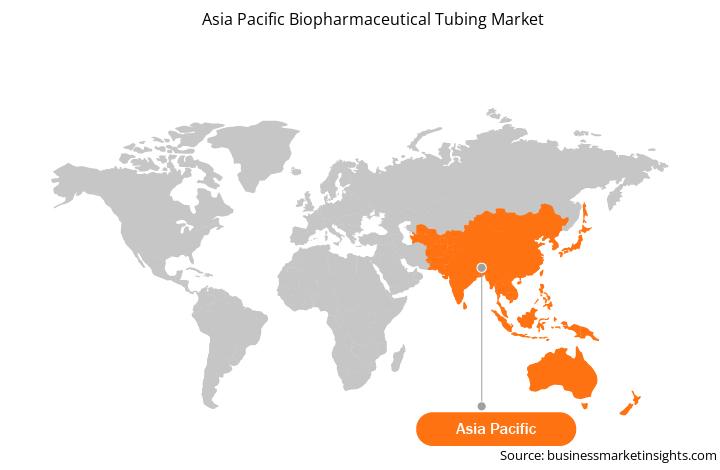亚太地区生物制药管市场预测至 2028 年 - COVID-19 影响以及按类型(塑料、金属和硅胶)和应用(制药、医疗器械、研发等)进行的区域分析
No. of Pages: 125 | Report Code: TIPRE00024061 | Category: Life Sciences
No. of Pages: 125 | Report Code: TIPRE00024061 | Category: Life Sciences
生物制药管材采用挤出工艺生产,广泛应用于药物输送系统、饲管等蠕动泵。这些产品具有卓越的热学、机械和化学特性,可用于各种微创应用,包括支架输送系统、心血管导管和泌尿外科检索设备。此外,这些还用于麻醉和呼吸设备、静脉注射和生物制药实验室设备。
亚太地区生物制药管材市场预计将从2021年的4.875亿美元增至2028年的9.0319亿美元;预计2021年至2028年复合年增长率为9.2%。市场的增长归因于世界老年人口增加和发展中经济体医疗保健行业激增等关键因素。然而,政府对生物制药应用的严格监管框架预计将限制预测期内的市场增长。
近年来,微创外科手术的受欢迎程度有所增加,原因是具有切口小、患者康复快、减少患者不适等优点。关节炎、癌症和心血管疾病的患病率不断上升,所有这些疾病都需要广泛的手术治疗,这增加了对微创手术的需求。因此,对导管和生物制药管材等组件的需求巨大。此外,生物制药管道系统价格合理,有助于节省时间。例如,使用导管进行心导管插入术和尿导管插入术可显着缩短医疗或外科手术所需的时间。因此,对微创医疗手术的需求不断增长以及对提高这些手术效率的关注在推动生物制药管材的需求方面发挥着重要作用。亚太国家以及其他发展中经济体的医疗保健行业预计在不久的将来将迅速扩张,预计增长可归因于客户需求的变化、医疗保健服务意识的提高以及人口老龄化的持续。因此,慢性病的日益流行迫使人们寻求医疗援助,这反过来又增加了医疗保健领域对导管和生物制药管材的需求。此外,政府在医疗保健设施上的支出增加和消费者购买力的增加也可能有助于医疗保健行业以及生物制药管材市场的增长。
亚太地区国家正面临着由于 COVID-19 发病率上升而带来的挑战。在药物输送、导管和医疗器械等广泛应用中的使用不断增加。插管和散装一次性管增加了对生物制药管市场的需求。然而,受疫情影响,医疗器械行业跌宕起伏,呼吸机、呼吸机等关键设备需求增加。尽管 COVID-19 造成了前所未有的破坏,但也为该地区的制药和医疗器械行业创造了机遇。许多公司还扩大了在该地区的业务,以克服供应链障碍。因此,COVID-19大流行对亚太地区生物制药管材市场的增长产生积极影响。
根据类型,亚太地区生物制药管道市场分为塑料、金属和硅胶。有机硅细分市场在 2021 年占据最大的市场份额,预计在预测期内将实现最高的复合年增长率。
根据应用情况,亚太地区生物制药市场管材市场分为制药、医疗器械、研发等。制药领域在 2021 年占据最大的市场份额,预计在预测期内将实现最高的复合年增长率。
p>
一些相关的主要和次要来源这份关于亚太地区生物制药管材市场的报告由经济合作与发展组织 (OECD)、印度品牌股权基金 (IBEF) 和疾病控制与预防中心 (CDC) 共同发布。
< strong>亚太地区生物制药管材市场细分
Strategic insights for Asia Pacific Biopharmaceutical Tubing involve closely monitoring industry trends, consumer behaviours, and competitor actions to identify opportunities for growth. By leveraging data analytics, businesses can anticipate market shifts and make informed decisions that align with evolving customer needs. Understanding these dynamics helps companies adjust their strategies proactively, enhance customer engagement, and strengthen their competitive edge. Building strong relationships with stakeholders and staying agile in response to changes ensures long-term success in any market.

| Report Attribute | Details |
|---|---|
| Market size in 2021 | US$ 487.50 Million |
| Market Size by 2028 | US$ 903.19 Million |
| Global CAGR (2021 - 2028) | 9.2% |
| Historical Data | 2019-2020 |
| Forecast period | 2022-2028 |
| Segments Covered |
By 类型
|
| Regions and Countries Covered | 亚太地区
|
| Market leaders and key company profiles |
The regional scope of Asia Pacific Biopharmaceutical Tubing refers to the geographical area in which a business operates and competes. Understanding regional nuances, such as local consumer preferences, economic conditions, and regulatory environments, is crucial for tailoring strategies to specific markets. Businesses can expand their reach by identifying underserved regions or adapting their offerings to meet regional demands. A clear regional focus allows for more effective resource allocation, targeted marketing, and better positioning against local competitors, ultimately driving growth in those specific areas.

The Asia Pacific Biopharmaceutical Tubing Market is valued at US$ 487.50 Million in 2021, it is projected to reach US$ 903.19 Million by 2028.
As per our report Asia Pacific Biopharmaceutical Tubing Market, the market size is valued at US$ 487.50 Million in 2021, projecting it to reach US$ 903.19 Million by 2028. This translates to a CAGR of approximately 9.2% during the forecast period.
The Asia Pacific Biopharmaceutical Tubing Market report typically cover these key segments-
The historic period, base year, and forecast period can vary slightly depending on the specific market research report. However, for the Asia Pacific Biopharmaceutical Tubing Market report:
The Asia Pacific Biopharmaceutical Tubing Market is populated by several key players, each contributing to its growth and innovation. Some of the major players include:
The Asia Pacific Biopharmaceutical Tubing Market report is valuable for diverse stakeholders, including:
Essentially, anyone involved in or considering involvement in the Asia Pacific Biopharmaceutical Tubing Market value chain can benefit from the information contained in a comprehensive market report.